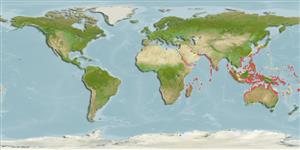Common names from other countries
>
Gobiiformes (Gobies) >
Gobiidae (Gobies) > Gobiinae
Etymology: Ctenogobiops: Greek, kteis, ktenos = comb + Latin, gobius = gudgeon + Greek, ops = appearance (Ref. 45335).
Environment: milieu / climate zone / depth range / distribution range
Ecologie
marien rifbewoner; diepte 1 - 15 m (Ref. 90102). Tropical
Indo-Pacific: widespread, from the Red Sea to the western Pacific, with records from the Great Barrier Reef and the Ryukyu Islands.
Grootte / Gewicht / Leeftijd
Maturity: Lm ? range ? - ? cm
Max length : 5.5 cm SL mannelijk / geslacht onbekend; (Ref. 90180)
Korte beschrijving
Determinatiesleutels | Morfologie | Morfometrie
Dorsale stekels (totaal) : 7; Dorsale zachte stralen (totaal) : 11 - 12; Anale stekels: 1; Anale zachte stralen: 11. This species is distinguished by the following characters: D VI + I,11-12; A I,11; pectoral rays 19; longitudinal scale series 55-60; body depth 4.8-5.2 in SL; head length (HL) 3.1-3.3 in SL; dorsal profile of snout forming an angle of about 40° to horizontal axis of head and body; wide gill opening, reaching forward nearly to a vertical at posterior edge of eye; 2nd dorsal spine equal to or slightly longer than first spine and longer than the third spine, and about equal to the body depth (0.9-1.1); rounded caudal fin, 1.1-1.3 in HL; body with 4 longitudinal rows of dark brown spots, the 1st and 3rd as thick dashes, the spots of second row much smaller, except large first one over upper end of gill opening; 4th row ventrally on body with 2 or 3 spots on abdomen approaching pupil size, remaining spots only dark flecks; postorbital head with 3 oblique rows of dark dashes at an angle less than 45°, the 1st a single long dash behind eye, the next 2 across cheek, ending on upper half of opercle; 4 oblique rows of dark brown dashes and dots from eye across lips; median, dark brown, V-shaped mark dorsally on snout absent; in life, no small yellow flecks ventrally on body; larger dark spots on ventral half of body often encircled with blue dots; pectoral fins with a small white dash at upper base, a long white streak from base, narrowing into middle of fin (Ref. 90180).
Levenscyclus en paargedrag
Maturities | Voortplanting | Spawnings | Egg(s) | Fecundities | Larven
Kovačić, M., S.V. Bogorodsky and J.E. Randall, 2011. Redescription of the Red Sea gobiid fish Ctenogobiops maculosus (Fourmanoir) and validation of C. crocineus Smith. Zootaxa 3054:60-68. (Ref. 90180)
Status op de Rode Lijst van het IUCN (Ref. 130435)
CITES (Ref. 128078)
Not Evaluated
Gevaar voor de mens
Harmless
Gebruik door de mens
Tools
Speciale rapporten
Download XML
Internetbronnen
Estimates based on models
Preferred temperature (Ref.
115969): 24.7 - 29.3, mean 28.4 (based on 2743 cells).
Fylogenetische diversiteitsindex (Ref.
82804): PD
50 = 0.5020 [Uniqueness, from 0.5 = low to 2.0 = high].
Bayesian length-weight: a=0.00708 (0.00333 - 0.01504), b=3.09 (2.92 - 3.26), in cm Total Length, based on LWR estimates for this (Sub)family-body shape (Ref.
93245).
Trofisch niveau (Ref.
69278): 3.5 ±0.45 se; based on food items.
Weerstandsvermogen (Ref.
120179): Hoog, minimale populatieverdubbelingstijd minder dan 15 maanden (Preliminary K or Fecundity.).
Fishing Vulnerability (Ref.
59153): Low vulnerability (10 of 100).
